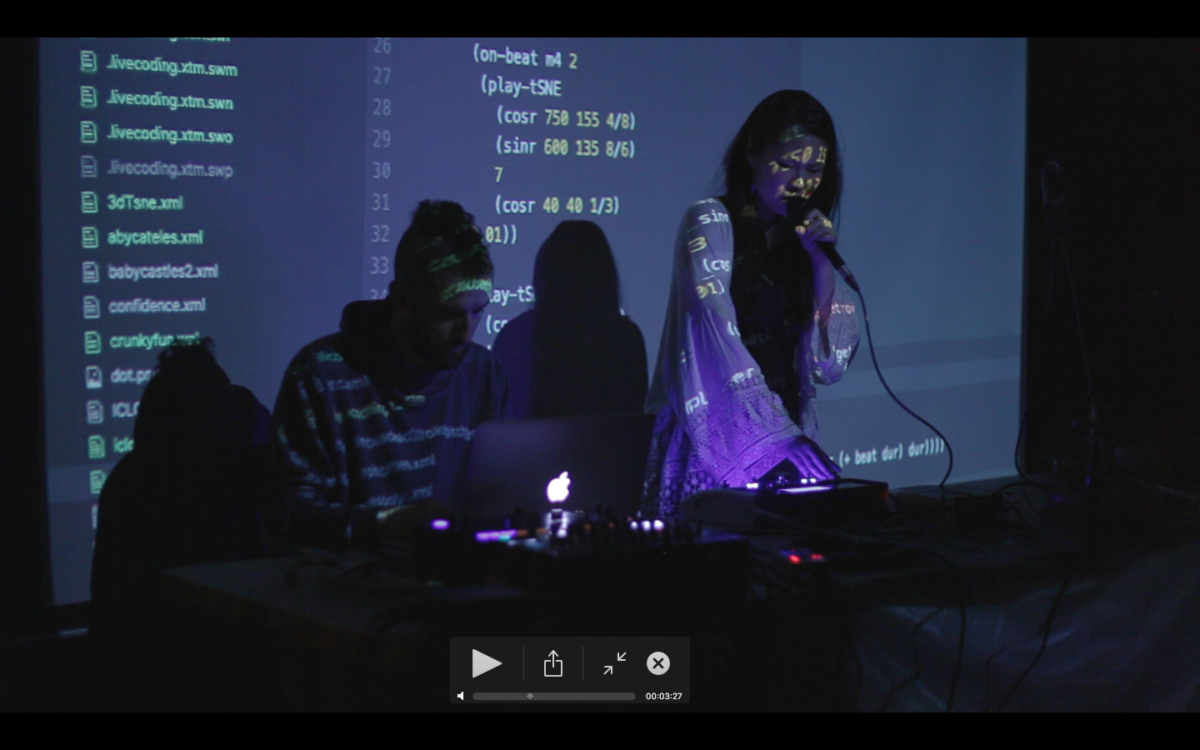It’s not uncommon, in this day and age, to go to a concert and spot a performer hunched behind a laptop. Head bobbing and fingers flying, she may be doing any number of things: DJing, remixing, playing live backing tracks. (Or, in the event of a systems failure, frantically trying to reboot.) Making electronic music has never been easier, thanks to the widespread availability of digital production platforms like Ableton Live. But a small contingent of technically-minded creatives has rejected the laptop musician’s typical arsenal of editing software and pre-mixed tracks. Instead, these enterprising souls simply write the code themselves, in real time.
Live Improvisation
The technique is known as “live coding,” and it is a specialty of the New York-based musician Jason Levine, one of MIT’s visiting artists this spring. Like many of his ilk, Levine performs with his code projected on a screen behind him. Those lines of technical jargon may be incomprehensible to the average concert goer, but the visual gimmick is an apt metaphor for the live coder’s plight. There is no troubleshooting in live coding, no chance to debug. All your mistakes, from the serendipitous to the catastrophic, are exposed.
For Levine, the allure of live coding is worth the risks. “It’s a medium where improvisation really goes far,” he explains. “Because not only are you controlling how these instruments play, but you can transform the instruments themselves. You can rebuild the instrument, because the instrument is code.”
Live coding is still in its infancy, and it is a relatively new pursuit for Levine, who first began experimenting with the medium in 2013. In past lives he has been an MC for a circus show, a game developer and an award-winning beatboxer. In more recent years he has turned his attention to the intersection of interactive video and performance art. It was his work in these mediums that brought him to the Piksel Festival in Norway, where he first encountered live coding in a demonstration by Alex McClean, a pioneer of the live coding movement.
“It was this geeky-looking British dude who was typing code and making beats,” Levine recalls. “And I said, ‘What the hell was that, that was incredible.’ And he said, ‘Oh it’s just a little thing I made,’ and he walked off.”
From that moment on, Levine was hooked.
“I kind of got obsessed,” he says. ‘[Live coding] lets you do a lot of interesting things that would be impossible for human musicians, or musicians playing traditional instruments. You can play any sequence of notes at any speed, you can hold any note for as long as you want.”

Improvements with Machine Learning
Still, some elements of music that come naturally to humans, like changing tempos and jamming with other musicians, are difficult to code on the fly. Levine’s project has been to make his process more organic. With the help of a machine learning algorithm, he is able to organize his vast sample library into a kind of geography, one that can be instinctively traversed with minimal code.
The result is groovy, warmly tactile music that stands in contrast to the “cold… scifi feel” of a lot of live coding, Levine says. He will perform his music live on April 10, 2018 at the MIT Museum. Levine sees the concert as a culmination of his work over the past five years, tinkering with algorithms and experimenting with sound.
“I want it to be an incredible performance, even if you don’t understand anything that I’m doing,” he says. “I don’t want it to just be a tech demo. I want the music and the art to be first.”
Embracing the Accidental
As part of his residency, Levine will also work with students in MIT’s “Art and Code” class, which is taught by music technology professor Eran Egozy. Egozy hopes that learning to live code will inspire his students to make art. “One of the things that I think is most difficult for some MIT students is just this—thinking of themselves as creative people,” he says.
For his part, Levine intends to teach students to embrace their mistakes—quite the opposite of what programmers are usually taught to do. “If you make a math error in your code and it sounds cool, use that,” he says. “To me those things are always more interesting than when you try to take an engineering idea and implement it. Because then you’re just taking ideas from the past that you’ve seen.”
Accident, in other words, is the mother of invention. And that is the crux of Levine’s practice. “It seems to me it’s interesting when things don’t work the way the creator intended,” he says. “And it’s beautiful.”

Public Lecture:
Combining Livecoding and Real-time Software for Musical Improvisation
April 10, 2018 / 6:00-8:00pm
MIT Museum, Building N51
265 Massachusetts Avenue, Massachusetts Avenue, Cambridge, MA
Workshop:
Live Coding Sinusoidal Traversals through Sound Sorted in Space
April 12, 2018 / 6:00-9:00pm
MIT Museum, Building N51
265 Massachusetts Avenue, Cambridge, MA




